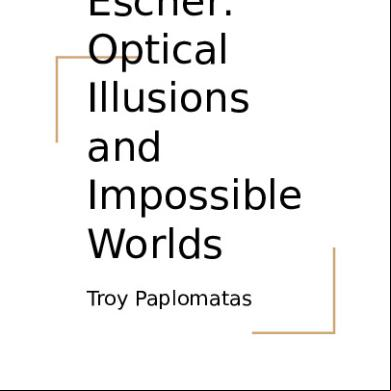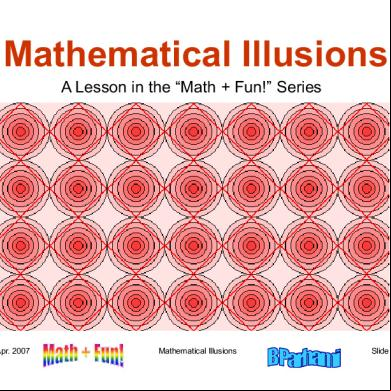M C Escher - Optical Illusions Impossible Worlds 4n2x
This document was ed by and they confirmed that they have the permission to share it. If you are author or own the copyright of this book, please report to us by using this report form. Report 3i3n4
Overview 26281t
& View M C Escher - Optical Illusions Impossible Worlds as PDF for free.
More details 6y5l6z
- Words: 627
- Pages: 11
Escher: Optical Illusions and Impossible Worlds Troy Paplomatas
Optical Illusions and Impossible Worlds
Drawing Hands (1948)
Belvedere (1958)
Ascending & Descending (1960)
Waterfall (1961)
Thesis M.C. Escher created the pieces Drawing Hands (1948), Belvedere (1958), Waterfall (1961), and Ascending & Descending (1960) by focusing on vantage points which created optical illusions and impossible figures. These pieces were all created with Escher’s intention to fool the human mind and create worlds that cannot physically be constructed.
Optical Illusion “A Perception, as of visual stimuli (optical illusion) that represents what is perceived in a way different from the way it is in reality,” (Dictionary.com)
Impossible Worlds “By introducing unusual vanishing points and forcing elements of a composition to obey them, Escher was able to render scenes in which the "up/down" and "left/right" orientations of its elements shift, depending on how the viewer's eye takes it in.”
Drawing Hands (1948) ”Two-dimensional drawings (on a flat surface) can be made to convey an illusion of three dimensional reality. Usually this deception is employed to depict realistic, solid objects in spatial relationships achievable in our world of sensory experience,” (Simanek 1996) “Those visions fed what would become Escher’s most celebrated works. In 1948, he made Drawing Hands, the image of two hands, each drawing the other with a pencil. It is a neat depiction of one of Escher’s enduring fascinations: the contrast between the two-dimensional flatness of a sheet of paper and the illusion of three-dimensional volume that can be created with certain marks. In Drawing Hands, space and the flat plane coexist, each born from and returning to the other, the black magic of the artistic illusion made creepily manifest,” (Poole 2015)
Belvedere (1958) “It may be that the appreciation of such visual paradoxes is one sign of that kind of creativity possessed by the best mathematicians, scientists and artists. M. C. Escher's artistic output included many illusion pictures and highly geometric pictures, which some might dismiss as `intellectual mathematical games' rather than art. But they hold a special fascination for mathematicians and scientists,” (Simanek 1996)
Ascending & Descending (1960) “This could be drawn with vanishing points in full perspective. M. C. Escher, in his 1960 lithograph Ascending and Descending (1960), (above) chose to construct the deception in a different manner. He placed the staircase on the roof of a building and structured the building below to convey an impression of conformity to strong (but inconsistent!) vanishing points. He has the right vanishing point higher than the left one,” (Simanek 1996)
Ascending & Descending (1960) explained...
Waterfall (1961) “If it could work, this would be the ultimate perpetual motion machine that also delivers power! If we look closely, we see that Mr. Escher has deceived us, and any attempt to build this structure using solid masonry bricks would fail,” (Simanek 1996)
Conclusion M.C. Escher is famous for his mathematical art, illusions, impossible worlds, and change of perspective. Each of Escher’s pieces; Drawing Hands (1948), Belvedere (1958), Ascending and Descending (1960), and Waterfall (1961), are some examples of Escher’s most famous impossible worlds and optical illusion artwork. Each of which primarily focused on distinct vantage points that deceive the human mind. All in all, Many of M.C. Escher’s works were created with the implementation of vantage points and generating optical illusions and impossible world art pieces.
Work Cited Lipson, Andrew. "Escher's "Waterfall" in LEGO®." Escher's "Waterfall" in LEGO. N.p., n.d. Web. 09 Apr. 2017. "ORIGINAL M.C. ESCHER ARTWORK Belvedere, Ascending and Descending, and Three Worlds." N.p., n.d. Web. 09 Apr. 2017. "Drawing Hands by M.C. Escher – Facts & History of the Painting." Totally History Drawing Hands Comments. N.p.,n.d. Web. 09 Apr. 2017. "Mathematical Art of M.C. Escher." Mathematical Art of M.C. Escher - Impossible World. N.p., n.d. Web. 09 Apr. 2017.
Optical Illusions and Impossible Worlds
Drawing Hands (1948)
Belvedere (1958)
Ascending & Descending (1960)
Waterfall (1961)
Thesis M.C. Escher created the pieces Drawing Hands (1948), Belvedere (1958), Waterfall (1961), and Ascending & Descending (1960) by focusing on vantage points which created optical illusions and impossible figures. These pieces were all created with Escher’s intention to fool the human mind and create worlds that cannot physically be constructed.
Optical Illusion “A Perception, as of visual stimuli (optical illusion) that represents what is perceived in a way different from the way it is in reality,” (Dictionary.com)
Impossible Worlds “By introducing unusual vanishing points and forcing elements of a composition to obey them, Escher was able to render scenes in which the "up/down" and "left/right" orientations of its elements shift, depending on how the viewer's eye takes it in.”
Drawing Hands (1948) ”Two-dimensional drawings (on a flat surface) can be made to convey an illusion of three dimensional reality. Usually this deception is employed to depict realistic, solid objects in spatial relationships achievable in our world of sensory experience,” (Simanek 1996) “Those visions fed what would become Escher’s most celebrated works. In 1948, he made Drawing Hands, the image of two hands, each drawing the other with a pencil. It is a neat depiction of one of Escher’s enduring fascinations: the contrast between the two-dimensional flatness of a sheet of paper and the illusion of three-dimensional volume that can be created with certain marks. In Drawing Hands, space and the flat plane coexist, each born from and returning to the other, the black magic of the artistic illusion made creepily manifest,” (Poole 2015)
Belvedere (1958) “It may be that the appreciation of such visual paradoxes is one sign of that kind of creativity possessed by the best mathematicians, scientists and artists. M. C. Escher's artistic output included many illusion pictures and highly geometric pictures, which some might dismiss as `intellectual mathematical games' rather than art. But they hold a special fascination for mathematicians and scientists,” (Simanek 1996)
Ascending & Descending (1960) “This could be drawn with vanishing points in full perspective. M. C. Escher, in his 1960 lithograph Ascending and Descending (1960), (above) chose to construct the deception in a different manner. He placed the staircase on the roof of a building and structured the building below to convey an impression of conformity to strong (but inconsistent!) vanishing points. He has the right vanishing point higher than the left one,” (Simanek 1996)
Ascending & Descending (1960) explained...
Waterfall (1961) “If it could work, this would be the ultimate perpetual motion machine that also delivers power! If we look closely, we see that Mr. Escher has deceived us, and any attempt to build this structure using solid masonry bricks would fail,” (Simanek 1996)
Conclusion M.C. Escher is famous for his mathematical art, illusions, impossible worlds, and change of perspective. Each of Escher’s pieces; Drawing Hands (1948), Belvedere (1958), Ascending and Descending (1960), and Waterfall (1961), are some examples of Escher’s most famous impossible worlds and optical illusion artwork. Each of which primarily focused on distinct vantage points that deceive the human mind. All in all, Many of M.C. Escher’s works were created with the implementation of vantage points and generating optical illusions and impossible world art pieces.
Work Cited Lipson, Andrew. "Escher's "Waterfall" in LEGO®." Escher's "Waterfall" in LEGO. N.p., n.d. Web. 09 Apr. 2017. "ORIGINAL M.C. ESCHER ARTWORK Belvedere, Ascending and Descending, and Three Worlds." N.p., n.d. Web. 09 Apr. 2017. "Drawing Hands by M.C. Escher – Facts & History of the Painting." Totally History Drawing Hands Comments. N.p.,n.d. Web. 09 Apr. 2017. "Mathematical Art of M.C. Escher." Mathematical Art of M.C. Escher - Impossible World. N.p., n.d. Web. 09 Apr. 2017.





